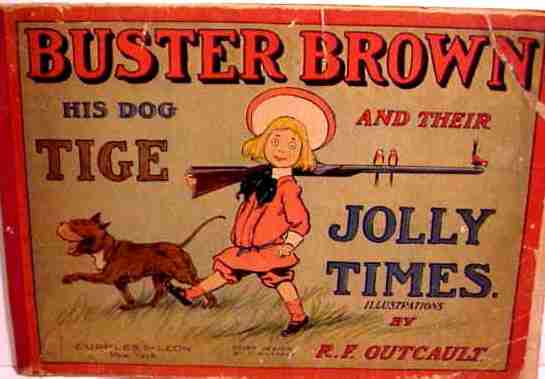
Figure 1.--Outcault usually drew Buster with a wide-brimmed sailor hat, red tunic suit and bloomer knickers, short red socks, and strap shoes.


Figure 1.--Outcault usually drew Buster with a wide-brimmed sailor hat, red tunic suit and bloomer knickers, short red socks, and strap shoes. |
R. F. Outcault as one of the most important comic artists of all time. His first boy character was The Yellow Kid who was enormously popular in America at the turn of the century. Outcault pioneered the comic in both Pulitzer's World and Hearst's Journal. Outcault is probably best known today for Buster Brown and his pal Mary Jane. His son Dickie, was not the model for Buster Brown but his daughter Mary Jane was the model for Buster's 'friend.
R.F. Outcault's The Yellow Kid was enormously popular in America at the turn of the century. In 1895 at the same time that Outcault's first panels were being published, the newspapers were experimenting with four color inks. Quite a bit of experimentation is required to get proper colors and when an engraver for the World wanted to try a new yellow he chose to spot it in the coming Sunday's paper on the "kid's"
frock, and the kid became known as "the Yellow Kid".
Outcault pioneered the comic in both Pulitzer's World and Hearst's Journal, where "The Yellow Kid" proved to be immensely popular--and immensely effective as a circulation builder. Hearst aggressively expanded his comic roster, adding such artists as Frederick Burr Opper, creator of "Happy Hooligan," and Rudolph Dirks, creator of "The Katzenjammer Kids," the latter of which is the oldest comic in syndication today.
Tired of the legal difficulties and looking for new avenues, Outcault left the Journal in 1901 and created for the New York Herald a forgotten strip called "Poor Li'l Mose" before finally creating the eternally famous "Buster Brown". Buster Brown the comic strip, first appeared in color in 1902. Buster and his dog, Tige, remained a popular comic and soon became even more famous as the emblem for a shoe company, a textile firm, and others. Hearst would lure him back to the Journal and he would remain there until 1920 when he discontinued the strip to concentrate his efforts on painting. believe Buster Brown was also drawn by Gus Meins, but I have few details on him.
H aving owned the rights to Buster Brown, he became an immensely wealthy man. He sold the right to merchandize an amazing diversity of products using the Buster Brown imagee. The most lucrative was the Brown Shoe Company, but there were many other products. He exhibited his works in several galleries and museums.
R. F. Outcault's creation the Yellow Kid was the first important cartoon about a boy. He demonstrated that the Sunday comics could sell newspapers and other forms of merchandise, and firmly established the comics as a permanent part of the American newspaper. The Yellow Kid, coupled with the artist's subsequent creations, Kelley's Kids, Pore Li'l Mose, Buddy Tucker, and Buster Brown, has firmly established R. F. Outcault as one of the most important comic artists of all time.
We do not know much about Outcault's life. A reader tells us, "R. F. Outcault had one son and one daughter. His son Dickie, was not the model for Buster Brown but his daughter Mary Jane was the model for Busters 'Mary Jane' in the Buster Brown comic strip. In the strip Mary Jane was Buster's sweetheart ... not his sister.
They were pals. I was raised by the real Mary Jane ( Outcault's daughter ) who was my grandmother and the kindest person in my experience. People gravitated to her like a magnet. Her husband Frank Pershing ( the Generals nephew ) was also a great guy, a star athelete and worked tirelessly for his family. They were wonderful people." [Coghlan]
A great grandson of Occult, John Coghlan, writes, "Enjoyed your site on Boys clothing. Especially Buster Brown related clothing as (of course I would be interested) R.F.Outcault who created Buster Brown was my great grandfather. Thank you for filling this little nitche in history." John also provided some information on clothing. His daughter said that RFO himself was quite 'katish' or 'dude' in perhaps 50s terminolgy and that he always dressed ahead of his time and was
experimental. But he was also interested in the current thinking of his time and was friends with Albert Hubbard and a great nature and animal lover. I have his daughters baby shoes ( that would be 1896 ) and a piece of ermine that was part of an outfit that actually appears in some of his Buster Brown strips. Unlike his daughter Mary Jane who is the model for Busters sweetheart in the strip, there was no actual model for Buster although I heard recently that Buster Brown might have been "loosely modeled after a kid in the neighborhood of RFOs Flushing home." But Mary Jane never mentioned that and I think she would have. But perhaps there is some truth to that of which I am not aware. RFO had a son but he was not the model for Buster."
Coghlan, John. E-mail message, April 27, 2006.
Navigate the HBC literary pages' Historical Clothing Web Site:
[Return to the main Main literary page]
[Return to the main Main Buster Brown suit page]
[England]
[France]
[Netherlands]
[United States]
Navigate the Boys' Historical Clothing Web Site:
[Introduction]
[Activities]
[Biographies]
[Chronology]
[Clothing styles]
[Countries]
[Bibliographies]
[Contributions]
[FAQs]
[Glossaries]
[Satellite sites]
[Tools]
[Boys' Clothing Home]